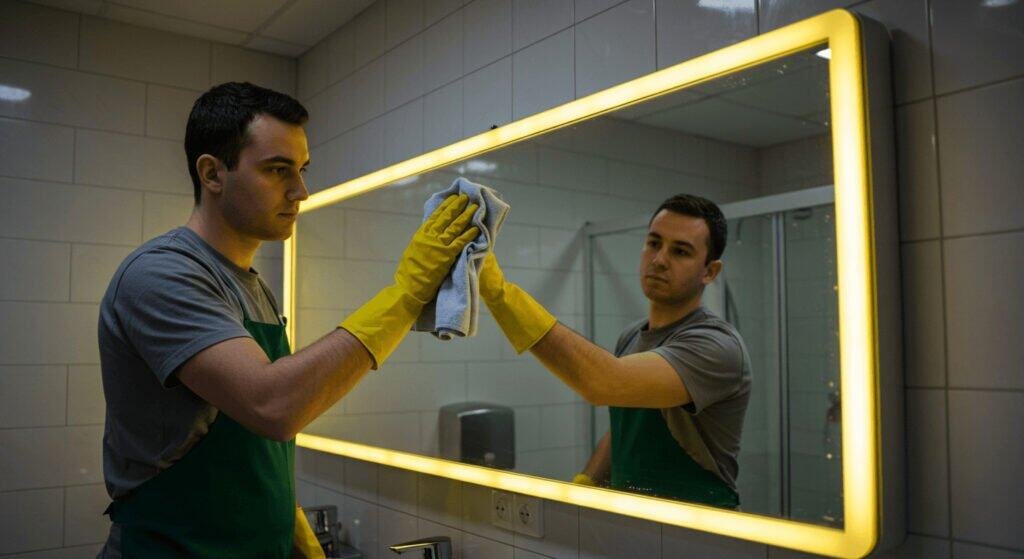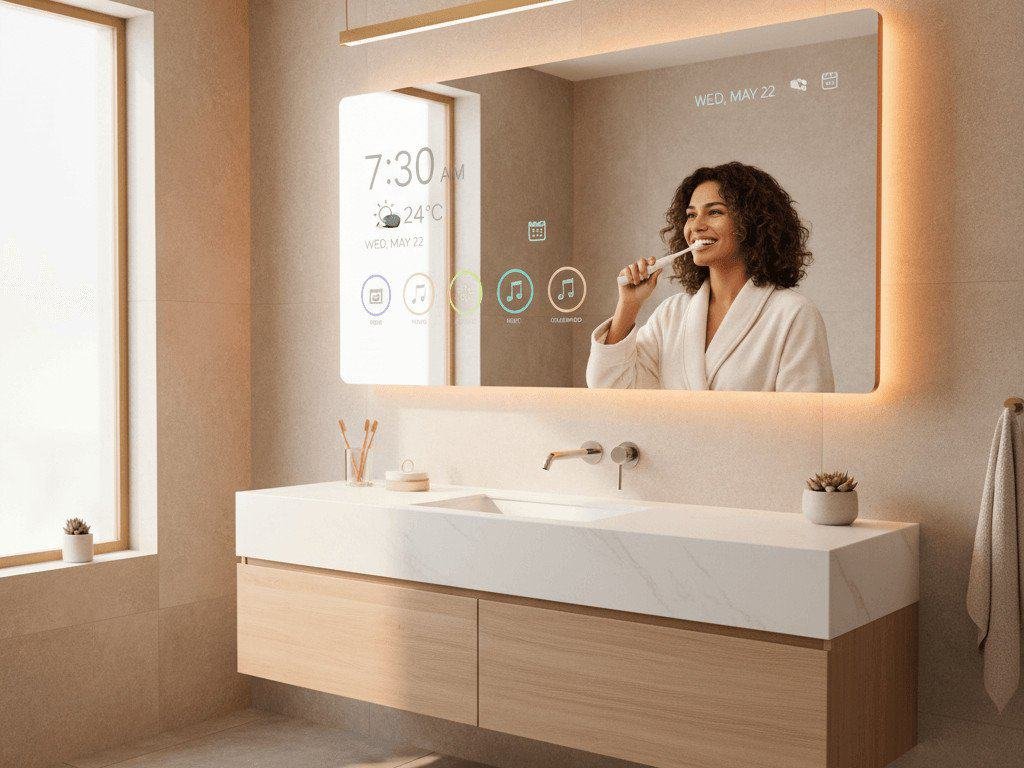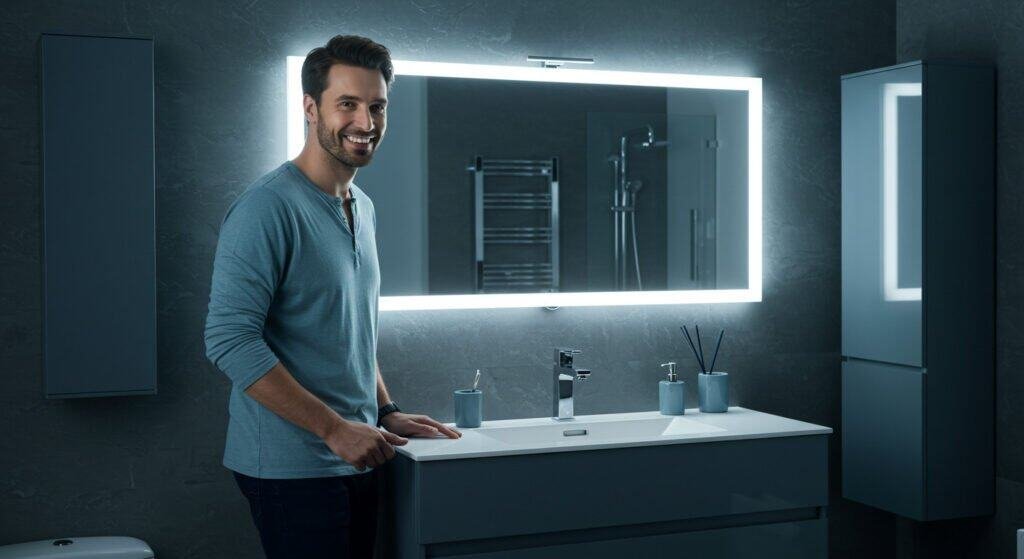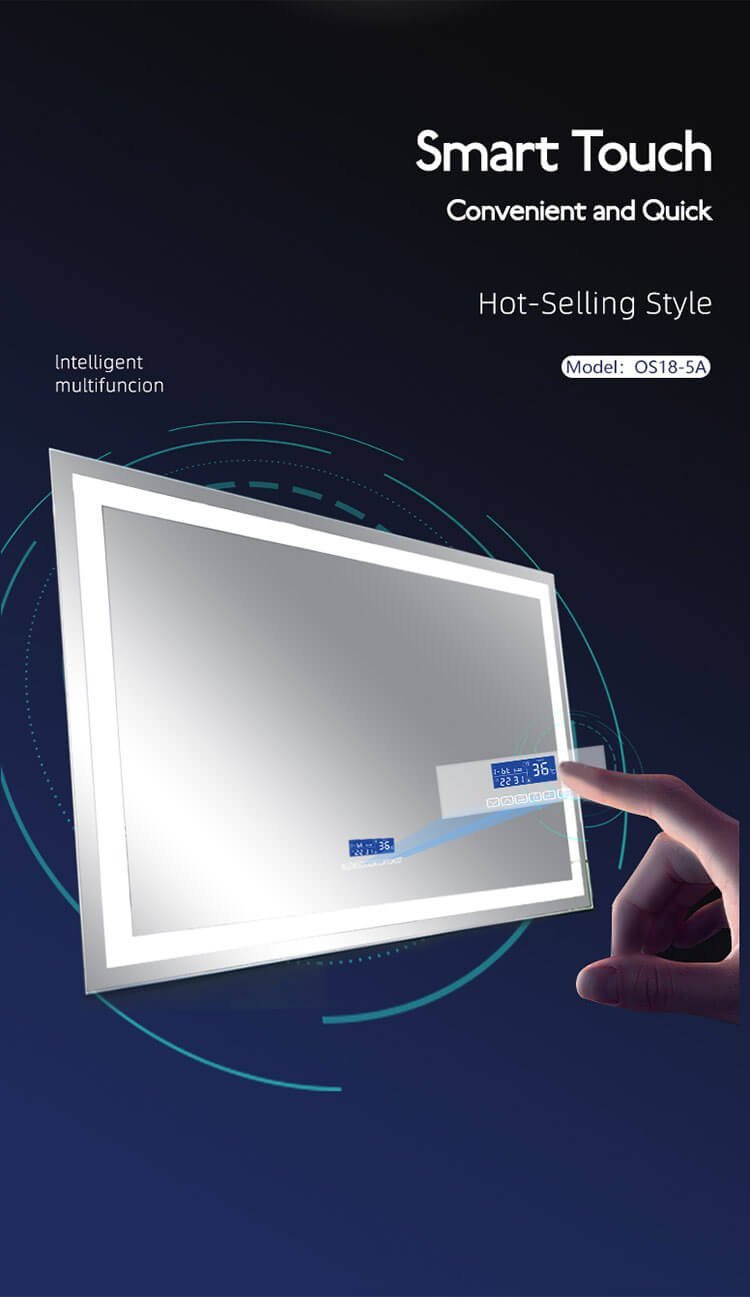How do anti fog mirrors work? Stepping out of a hot shower only to find your bathroom mirror completely fogged up is frustrating. You cannot see your reflection clearly, which makes getting ready in the morning more difficult and wastes time wiping down the foggy mirror bathroom surface over and over.
Anti-fog mirrors work by keeping the mirror surface warmer than the surrounding air, which stops water droplets from forming. The most common method uses an electric heating element installed behind the glass mirror that gently warms the surface, while other options use special anti-fog mirror coating that pushes moisture away. Both approaches ensure your bathroom mirror stays clear even during the steamiest showers.
Learning how these mirrors work will help you pick the right solution for your bathroom and decide whether professional anti-fog technology or DIY methods work better for your situation.

What Technology Powers Anti-Fog Mirrors?
Anti-fog mirrors use two main technologies to keep your reflection clear, and understanding both helps you choose the right product for your needs.
The heating pad system works by installing a thin electric heater behind the mirror surface that warms the glass just enough to prevent condensation. The other approach applies a special coating to the mirror surface that changes how water behaves when it touches the glass.
Heating pad systems are the most reliable option for busy bathrooms. These systems consist of a thin heating element attached to the back of your bathroom mirror that connects to your bathroom’s electrical system. When turned on, the heater warms the mirror surface to approximately 5-10 degrees above room temperature, which stops water vapor from turning into droplets. Many modern lighted bathroom mirrors and led bathroom mirrors come with built-in heating pads that activate automatically when you turn on the vanity lights. This technology works similarly to your car’s rear window defogger and delivers consistent results regardless of how much steam your shower produces. The heating element is typically paper-thin and does not add noticeable thickness to your bathroom vanity mirrors.
Coating-based systems apply a hydrophilic layer to the mirror surface that spreads water into an ultra-thin, transparent film instead of allowing droplets to form. When steam contacts a coated mirror, the moisture spreads evenly across the surface rather than creating the scattered droplets that block your view. This technology does not require electricity, making it suitable for renters or situations where electrical installation is not practical. However, these coatings gradually wear away from regular cleaning and typically need reapplication every few months. You can find coating products marketed as the best anti-fog spray for bathroom mirror at most home improvement stores, though professional factory-applied coatings last significantly longer than spray-on options.
Do Anti-Fog Mirrors Really Work?
Yes, properly designed anti-fog mirrors work effectively, though their performance depends heavily on the technology used and the quality of manufacturing.
Anti-fog bathroom mirrors with heating elements provide the most reliable fog prevention, maintaining clear visibility even in extremely steamy conditions. Coating-based solutions work well initially but require maintenance to sustain their effectiveness over time.
Heated anti-fog mirrors deliver consistent performance because they address the root cause of mirror fogging by controlling the surface temperature. The physics behind this approach is straightforward: when the mirror surface stays warmer than the air around it, water vapor cannot condense into droplets. Professional anti-fog bathroom mirror with light products combine LED illumination with integrated heating pads that activate simultaneously, ensuring your mirror stays clear from the moment you enter the bathroom. Many users on anti-fog bathroom mirror Reddit discussions report that quality heated mirrors eliminate fogging completely, even in small bathrooms with poor ventilation where steam concentrations are highest.
The effectiveness of coating-based solutions varies more significantly. Factory-applied coatings on new mirrors typically last six months to two years before requiring maintenance, while spray-on products like those marketed as best anti-fog spray for mirrors may only last a few weeks. The coating performance also depends on your cleaning habits since abrasive cleaners can damage the anti-fog layer. Despite these limitations, coatings work well for moderate fogging conditions and offer a budget-friendly option for those who cannot install heated mirrors. Some retailers like anti-fog mirror IKEA offer mirrors with factory-applied coatings at accessible price points, making this technology available to a broader range of consumers.

How Do I Make My Mirror Anti-Fog?
You can make your existing mirror fog-resistant using several DIY methods or upgrade to a professionally designed anti-fog solution for permanent results.
DIY methods include applying household products like shaving cream or dish soap to create a temporary protective layer, while professional solutions involve installing heating pads or purchasing mirrors with factory-applied coatings. Each approach offers different levels of effectiveness and longevity.
Comparison of Anti-Fog Solutions
| Method | Effectiveness | Duration | Cost | Installation Difficulty |
|---|---|---|---|---|
| Shaving Cream Application | Moderate | 1-2 weeks | Very Low ($3-5) | Very Easy |
| Dish Soap Method | Moderate | 3-7 days | Very Low ($2-3) | Very Easy |
| Commercial Anti-Fog Spray | Good | 2-4 weeks | Low ($10-20) | Easy |
| Adhesive Heating Pad | Excellent | Permanent | Moderate ($40-80) | Moderate |
| Factory-Coated Mirror | Good | 6-24 months | Moderate ($80-150) | Easy |
| Integrated Heated LED Mirror | Excellent | Permanent | High ($150-500) | Moderate to Difficult |
The simplest DIY approach involves applying a thin layer of shaving cream to your clean, dry mirror and buffing it off with a soft cloth. The residual layer left behind temporarily prevents water droplets from forming. This method works because shaving cream contains surfactants that reduce surface tension, causing water to spread into a thin film rather than forming droplets. However, this solution washes away quickly with regular bathroom cleaning and typically lasts only one to two weeks. A similar technique uses a drop of dish soap spread across the mirror surface with a damp cloth and then buffed dry. Both methods provide temporary relief and cost almost nothing, making them worth trying before investing in permanent solutions.
For longer-lasting results without replacing your mirror, adhesive heating pads offer an excellent middle-ground solution. These thin heating elements stick to the back of your existing rectangular bathroom mirrors and connect to your bathroom’s electrical system. Quality heating pads from reputable manufacturers can transform your standard mirror into an effective anti-fog bathroom mirror with light when combined with your existing vanity bathroom lights. Installation requires basic electrical skills or hiring an electrician to connect the pad to a switch or your bathroom lighting circuit. This option works particularly well for modern bathroom mirror installations where you want to keep your current mirrors with black frame or other decorative elements while adding anti-fog functionality.
The most effective permanent solution is replacing your mirror with a dedicated anti-fog model. Modern lighted mirrors for bathrooms often include integrated heating systems that activate automatically with the LED lights, providing both illumination and fog prevention. These lighted vanity mirrors come in numerous styles, from wall mirror with lights designs to backlit mirror configurations that add ambient lighting to your space. A vanity mirror with LED lights that includes heating technology costs more upfront but eliminates fogging permanently without any maintenance. For those interested in the best anti-fog spray for mirrors as a simpler alternative, commercial sprays formulated specifically for mirrors perform better than household products and can last several weeks between applications, though they still require regular reapplication.

Why Is My Anti-Fog Mirror Fogging Up?
When your anti-fog mirror starts fogging despite its special features, several common issues might be causing the problem, and most are fixable.
Anti-fog mirrors typically fog up due to heating element failure, incorrect installation, worn-out coating, insufficient power supply, or simply needing proper activation. Identifying which issue affects your mirror helps you apply the correct solution.
For heated mirrors, the most common problem is that the heating function is not actually turned on. Many led vanity mirror models require manual activation through a dedicated switch, touch button, or connection to your vanity bathroom lights. Check whether your mirror has a separate control for the heating element that you might have overlooked. Some lighted vanity mirrors only activate their heating function when connected to a specific switch or when the ambient temperature drops below a certain threshold. If your mirror is new and fogging immediately, review the installation manual to confirm you have connected all electrical components correctly and located all controls.
Electrical connection problems frequently cause heating failure in anti-fog bathroom mirrors. Loose wiring, tripped circuit breakers, or faulty switches can interrupt power to the heating element while the LED lighting continues to work. Because the lights and heating pad sometimes operate on separate circuits within the mirror, you might assume the mirror is functioning correctly because the vanity lights illuminate properly. Use a multimeter to test whether power is reaching the heating element, or consult a qualified electrician to inspect the connections. Inadequate power supply can also cause partial heating that is insufficient to prevent condensation in very steamy conditions.
For coating-based mirrors, degradation over time is the most likely culprit. Anti-fog mirror coatings wear away gradually through regular cleaning, especially if you use abrasive cleaners or rough cloths. Ammonia-based glass cleaners and paper towels are particularly harmful to these coatings. If your coated mirror worked well initially but now fogs in the same areas where you clean most frequently, coating wear is probably responsible. You can restore function by purchasing a quality anti-fog spray for mirrors and reapplying it according to the manufacturer’s instructions. Some mirrors allow you to have the coating professionally reapplied, though this option may cost nearly as much as a new small bathroom mirror.
Manufacturing defects occasionally occur even in quality products. If your anti-fog bathroom mirror with light fogged from the first use despite correct installation and operation, the heating element might be undersized for the mirror dimensions or placed incorrectly during manufacturing. Inadequate coverage means some mirror areas stay too cool to prevent condensation. Contact the manufacturer or retailer for warranty service, as reputable companies will replace defective units. When purchasing anti-fog mirrors, choose established manufacturers who stand behind their products rather than unknown brands offering suspiciously low prices.
Can a Mirror Fog Up from a Cold Shower?
A mirror typically will not fog up from a cold shower because fogging requires warm water vapor, which cold water does not produce in significant quantities.
Mirrors fog when warm, moist air contacts a cool surface and condenses into droplets. Cold showers do not generate enough water vapor to cause this condensation, so your bathroom mirror stays clear even without anti-fog features.
The science behind mirror fogging explains why cold showers behave differently than hot ones. Fogging occurs when warm air, which can hold substantial moisture, suddenly cools upon contact with your cold mirror surface. As the air cools, it loses its ability to hold water vapor, forcing the excess moisture to condense into visible droplets. Cold showers do not raise the air temperature or add significant moisture to your bathroom atmosphere. When you run cold water, very little evaporation occurs because cold water lacks the thermal energy needed to transition from liquid to gas phase. Without this water vapor entering the air, there is nothing to condense on your mirror surface. This is why your bathroom mirror with lights stays clear during cold showers even if it would fog immediately during a hot shower.
However, your mirror might still fog during a cold shower under specific circumstances. If your bathroom is extremely warm and humid before you shower, perhaps from someone else’s recent hot shower or from summertime heat and humidity, then even the minimal moisture from a cold shower could contribute to fogging. Additionally, if your bathroom has very poor ventilation and you take a very long cold shower, some minor evaporation might occur that could cause slight fogging on the coldest parts of your modern bathroom mirror. These situations are unusual, though, and the fogging would be far less severe than what occurs during hot showers.
Temperature differential is the key factor in mirror condensation. During hot showers, your small bathroom mirror surface stays relatively cool while the surrounding air becomes extremely warm and moisture-laden, creating a large temperature difference that drives condensation. During cold showers, both the air and the mirror remain at similar cool temperatures, preventing the temperature gradient necessary for condensation. This principle is why you might notice your backlit mirror fogs in winter bathrooms more readily than in summer because the mirror surface starts colder and creates a larger temperature difference with the shower steam. Understanding this mechanism helps explain why anti-fog technology focuses on warming the mirror rather than cooling the air, since eliminating the temperature difference prevents condensation regardless of humidity levels.

Anti-Fog Technology Lifespan Comparison
| Technology Type | Initial Effectiveness | Maintenance Required | Expected Lifespan | Replacement/Renewal Cost |
|---|---|---|---|---|
| Electric Heating Pad (Built-in) | Excellent | Minimal (electrical checks) | 10-15+ years | Full mirror replacement |
| Electric Heating Pad (Adhesive) | Excellent | Minimal (electrical checks) | 5-10 years | $40-80 |
| Factory-Applied Coating | Good to Excellent | Gentle cleaning only | 6-24 months | Spray reapplication ($10-20) |
| Professional Anti-Fog Spray | Good | Reapplication every 2-6 weeks | 2-6 weeks per application | $10-20 per bottle (20-30 applications) |
| DIY Solutions (shaving cream, soap) | Moderate | Reapplication every 3-14 days | 3-14 days per application | $2-5 (hundreds of applications) |
Environmental factors also influence how long anti-fog function lasts. Bathrooms with excellent ventilation place less demand on anti-fog systems because steam clears quickly, reducing the time the mirror must actively resist fogging. Conversely, small bathrooms with poor airflow create more challenging conditions that can accelerate coating wear or require heated mirrors to operate longer per shower. Water quality matters as well since hard water deposits can build up on mirror surfaces and interfere with both coating function and heat distribution. Regular cleaning with appropriate products extends the life of both coating and heated systems by preventing mineral buildup that can insulate the mirror surface from the heating element or create rough spots that disrupt coating uniformity.
Do Anti-Fog Mirrors Consume Much Electricity?
Anti-fog mirrors with heating elements consume very little electricity, typically adding only a few dollars per year to your energy costs even with daily use.
Heated anti-fog mirrors draw between 12 and 50 watts depending on mirror size, which is less power than most standard light bulbs. For a typical bathroom vanity mirror, operating the heating function for 30 minutes daily costs approximately $2-5 per year at average electricity rates.
To put this energy consumption in perspective, a medium-sized led bathroom mirror with a 20-watt heating pad uses less power than a single old-style incandescent light bulb and far less than most bathroom exhaust fans. If you operate the heating function for 30 minutes each morning while you shower and get ready, the mirror consumes 0.01 kilowatt-hours per day. At the average US electricity rate of approximately $0.13 per kilowatt-hour, this equals about $0.47 per year in operating costs. Even large bathroom vanity mirrors with 50-watt heating systems cost under $2.50 annually if used 30 minutes daily. This minimal expense explains why energy efficiency rarely factors into purchasing decisions for anti-fog mirrors.
The power consumption is so low because anti-fog systems only need to warm the mirror slightly above ambient temperature rather than heating it substantially. Unlike hair dryers that must produce intense heat or bathroom heaters that must warm an entire room, anti-fog heating pads only need to raise the mirror surface temperature by 5-10 degrees Fahrenheit. This modest temperature increase requires very little energy. Additionally, modern anti-fog mirrors use efficient electrical resistance heating that converts nearly 100% of electrical energy into heat with virtually no waste. Some advanced lighted vanity mirrors for bathroom include smart controls that automatically shut off the heating element after a preset time or when the bathroom humidity drops below a certain threshold, further reducing energy consumption.
Comparing the anti-fog heating element to other components in your bathroom vanity system reveals its minimal impact. The LED lights in your lighted bathroom mirror typically consume 10-30 watts, similar to or exceeding the heating pad consumption. Your bathroom exhaust fan likely draws 50-100 watts, significantly more than the mirror heater. A typical bathroom radiator or space heater draws 1000-1500 watts, making the mirror heater consumption nearly invisible by comparison. Even the small bathroom mirror in a powder room with a 12-watt heater costs less than $0.75 per year to operate for 30 minutes daily. The integrated nature of modern vanity mirror with LED lights designs means you control both lighting and heating with a single switch, making it impossible to accidentally leave the heater running when not needed.
Some homeowners worry about safety related to electrical components in humid bathroom environments, but properly installed anti-fog mirrors meet strict electrical safety standards. The heating elements operate at low voltages and temperatures that present no fire risk, and quality products include GFCI protection and waterproof seals that make them as safe as your bathroom light fixtures. The small energy draw means the heating pad barely warms to the touch even after extended operation, eliminating any burn risk. For wall mirror with lights installations that include integrated heating, all electrical components meet the same bathroom safety standards that govern light up vanity mirror fixtures and vanity bathroom lights.

What Certifications Should Quality Anti-Fog Mirrors Have?
Quality anti-fog mirrors should carry several key certifications that verify electrical safety, water resistance, and overall product quality standards essential for bathroom environments.
Critical certifications include UL or ETL electrical safety certification, IP44 or higher moisture protection rating, CE marking for European standards compliance, and Energy Star certification for efficiency. These certifications ensure the mirror meets rigorous testing standards and operates safely in humid bathroom conditions.
Electrical safety certification represents the most fundamental requirement for any lighted bathroom mirror with heating elements. In North America, look for UL (Underwriters Laboratories) or ETL (Intertek) certification marks on the mirror or its packaging. These certifications verify that independent testing laboratories have evaluated the product’s electrical components, wiring, insulation, and grounding systems according to strict safety standards. The certification process tests whether the heating element maintains safe operating temperatures, whether all electrical components resist moisture intrusion, and whether the product includes appropriate ground fault protection. Without these certifications, you cannot be certain the mirror meets basic electrical safety requirements, which is particularly important in bathrooms where water and electricity coexist. Reputable manufacturers of led vanity mirror products prominently display these certification marks because they understand that safety-conscious consumers and professional contractors will only specify certified products.
IP (Ingress Protection) ratings measure how well the mirror resists moisture and dust intrusion. The IP rating appears as two digits, with the first indicating dust protection and the second indicating water protection. For bathroom applications, focus on the second digit related to moisture resistance. An IP44 rating means the mirror is protected against water splashing from any direction, which represents the minimum acceptable standard for bathroom mirrors. Higher ratings like IP54 or IP65 provide even greater protection against sustained water exposure or direct water jets, making them suitable for installation directly in shower enclosures or very humid environments. The IP rating specifically applies to the electrical components rather than the mirror surface itself. A properly rated anti-fog bathroom mirror with light can safely operate in steamy conditions without risk of electrical malfunction, corrosion, or dangerous short circuits. When comparing products, higher IP ratings indicate more robust construction and better long-term reliability in challenging bathroom conditions.
CE marking is essential for products sold in European markets and increasingly appears on quality products sold globally. The CE mark indicates the manufacturer has assessed the product against European health, safety, and environmental protection standards. While not mandatory in North America, CE certification suggests the manufacturer follows internationally recognized quality standards and sells products in multiple markets, which typically indicates established manufacturing processes and quality control systems. For specialized items like backlit mirror designs with complex electronics, CE marking provides additional assurance that electromagnetic emissions remain within acceptable limits and do not interfere with other household electronics.
Additional certifications and standards to consider include Energy Star certification for energy efficiency, though this applies more commonly to lighting fixtures than heating elements. Some manufacturers also obtain certifications from organizations like the Canadian Standards Association (CSA) or specific industry associations that establish quality standards for lighting and mirror products. Warranty coverage, while not a certification, indicates manufacturer confidence in product quality and longevity. Quality anti-fog mirrors typically include warranties of at least 2-3 years covering electrical components and heating elements, with some premium manufacturers offering 5-year warranties on led bathroom mirror products. Longer warranties suggest the manufacturer uses quality components and stands behind product performance, which is particularly valuable for products like lighted vanity mirrors for bathroom that represent significant investments.
When evaluating certifications, verify they apply specifically to the complete assembled product rather than just individual components. Some manufacturers use certified LEDs or heating elements but fail to certify the finished mirror assembly, which means the integration of these components has not been independently verified for safety. Purchasing from established manufacturers who serve professional contractors and commercial projects provides additional assurance, as these professionals require full certification for liability and code compliance reasons. For any wall mirror with lights or modern lighted mirrors for bathrooms installation, confirm the product documentation includes certification numbers that can be verified with the issuing organization, and ensure your electrician installs the product according to all manufacturer specifications to maintain certification validity and warranty coverage.

Conclusion
Anti-fog mirrors eliminate the frustration of foggy bathroom mirrors through proven heating or coating technology. Understanding how these systems work helps you choose between permanent heated solutions or maintenance-requiring coatings based on your budget, installation capabilities, and performance expectations. Whether you select a sophisticated led mirror with integrated heating or apply DIY methods, clear mirrors improve your daily routine significantly.
- Clik here to know What Is Copper Free Mirror?
- If you donot know how too choose the right bathroom height click here.
- Know more about LED bathroom mirror Problems
- Clik here to know why Touch Sensor Mirror Not Working
- Clik here to know What Are Standard Vanity Mirror Sizes?
- Clik here to know Why Are Mirrors So Expensive?
- Clik here to know Do LED Mirrors Need Electricity?
- Clik here to know Is a Lighted Mirror Enough Light for a Bathroom?
- Find out 10 Common LED Bathroom Mirror Problems Click Here



